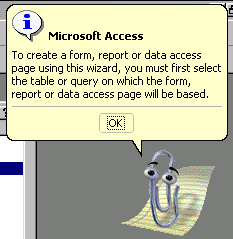
Access 2000
Creating a Report
Introduction
By the end of this lesson, learners should be able to:
- Create a report using AutoReport
- Create a report using the Report Wizard
Reports
In the preceding Access 2000 lessons, you learned about tables, forms, and queries. In this lesson, you'll learn about another database object, reports.
Although you can print datasheets and forms in Access, creating a report makes your data more presentable and meaningful. Using Access, you can report your data in variety of ways to make it more accessible to those who need it.
Most reports are either columnar or tabular (as shown below) in design.

AutoReport
You can develop reports many ways, but in this lesson, we'll discuss how to create a report using AutoReport and the Report Wizard.
Some of the simplest reports to produce, AutoReports are extremely useful; especially if all the data you want is in one table or query.
To Create an AutoReport:
- Open the database window. Choose Report from the Object palette.

- Click New to open the New Reports dialog box.
![]()
- Choose AutoReport: Columnar or AutoReport: Tabular.

- Click the drop-down list and choose the table or query on which the report or query is based.

- If you forget this step, the Office Assistant gives you the following error message:

- Click OK to create the report and open it in Print Preview. Your mouse pointer changes to the magnifying glass. Remember, you cannot edit data in print preview.
 When
you save a report, only the structure of the report is saved, not the underlying
data you see in the preview. Data shown in the preview is always as current
as the records in the database.
When
you save a report, only the structure of the report is saved, not the underlying
data you see in the preview. Data shown in the preview is always as current
as the records in the database.
The Report Wizard
The Report Wizard asks a series of questions and uses responses to create a report.
To Create a Report using the Report Wizard:
- Open the database window. Choose Reports from the Object palette.

- Click New to open the New Reports dialog box.
![]()
- Choose Report Wizard.

- Click the drop-down list and choose the table on which the report or query is based.

- Click OK to begin the Report Wizard.
 When
you save a report, only the structure of the report is saved, not the underlying
data you see in the preview. Data shown in the preview is always as current
as the records in the database.
When
you save a report, only the structure of the report is saved, not the underlying
data you see in the preview. Data shown in the preview is always as current
as the records in the database.
Using the Report Wizard
In the Report Wizard's first dialog box, choose the table or query on which to base the report. Click the right arrow to move individual fields to the Selected Fields box, or the double arrow to move all the fields. When you have selected all the fields you want from the first table/query, select the next object from the list. Click Next.

 Follow the Report Wizard's directions carefully. Click Finish to close the Report Wizard and open your report in Print Preview.
Follow the Report Wizard's directions carefully. Click Finish to close the Report Wizard and open your report in Print Preview.
 You
can decide to include any or all of the Report Wizard's selections in your
report.
You
can decide to include any or all of the Report Wizard's selections in your
report.
 Very
Important! When working in tables, forms, queries, and reports, use
the New Object button
Very
Important! When working in tables, forms, queries, and reports, use
the New Object button  on the toolbar to create new database objects (tables, forms,
queries, reports).
on the toolbar to create new database objects (tables, forms,
queries, reports).
Challenge!
- Open the Great Lake Elementary database.
- Choose Reports from the Object palette.
- Click New to open the New Reports dialog box.
- Practice creating an AutoReport.
- Practice creating a report using the Report Wizard.
- Close the report. The report will be automatically saved.